A
Auto Express
Guest
An updated version of the Jaguar E-Pace crossover has been launched. Exterior styling tweaks mask a switch to the same PTA platform as the latest Range Rover Evoque, allowing an all-new infotainment system and a fresh plug-in powertrain.
On the outside, the facelifted E-Pace features a redesigned front bumper, a new mesh radiator grille and a fresh pair of LED headlights, which feature Jaguar’s latest ‘Double J’ lighting signature. Jaguar has also fitted a new undertray at the rear, along with revised LED tail-lights that are inspired by the units fitted to the all-electric I-Pace.
The changes to the cabin include a new drive selector, soft-touch trim around the instrument binnacle and a reshaped transmission tunnel, which makes more room for the driver’s knee.
The E-Pace also now benefits from a new 11.4-inch infotainment system, which is powered by JLR’s latest Pivi software. Jaguar says the screen has been designed for ease of use; 90 per cent of the system’s functions, such as media and navigation, can be accessed with just two inputs.
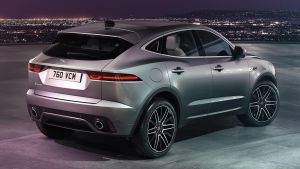
image

image
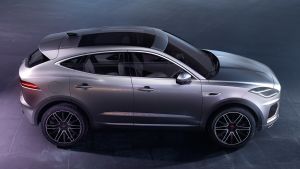
image
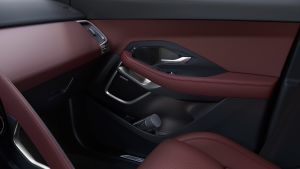
image
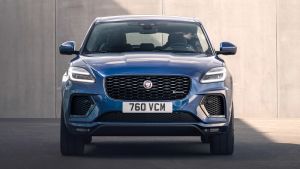
image
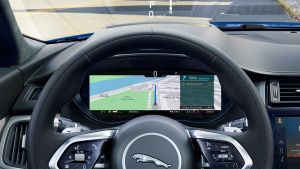
image

image
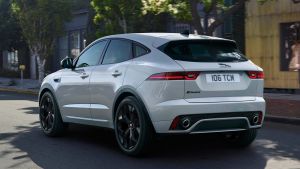
image
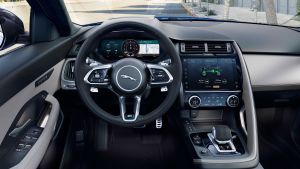
image
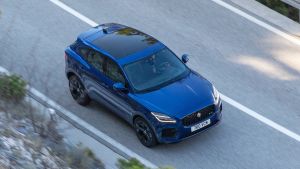
image
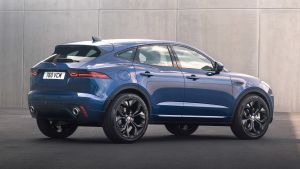
image

image
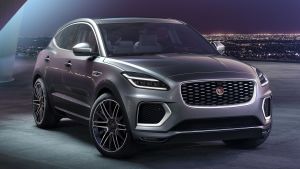
image

image
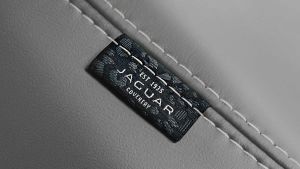
image

image
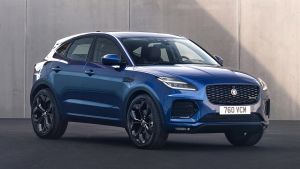
image

image

image
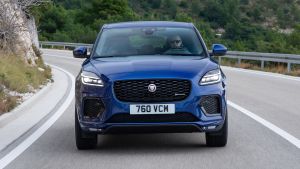
image
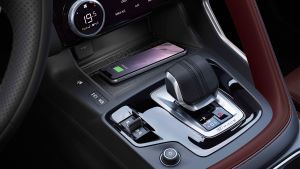
image
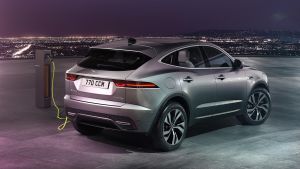
image
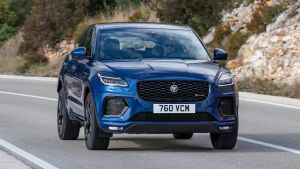
image
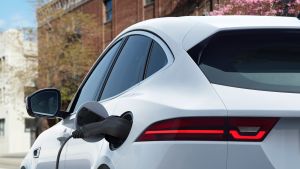
image
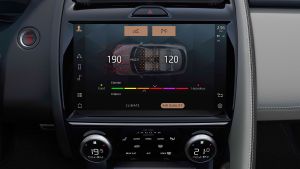
image
Over-the-air updates for software tweaks and mapping are supported as standard, while the touchscreen is paired with an updated 12.3-inch digital instrument cluster, which features displays for navigation, media and contact details.
The engine line-up has been updated, too, and comprises three diesels, three petrols and a plug-in hybrid powertrain. The diesel range uses Jaguar’s 2.0-litre four-cylinder unit, and can be specced either with or without mild-hybrid assistance.
The entry-level model has 161bhp and 380Nm of torque, which is sent through a six-speed manual gearbox to the front wheels. Add four-wheel drive and a nine-speed auto gearbox, and the engine is backed up by a 48-volt integrated starter-generator and a compact lithium-ion battery pack. The flagship 201bhp diesel uses the same gearbox and four-wheel-drive set-up.
The petrol line-up is also based around a 2.0-litre turbo four-cylinder unit, with buyers offered a choice of 197bhp, 246bhp or 296bhp outputs. The three petrols all feature mild-hybrid technology and come with the nine-speed automatic gearbox and four-wheel-drive system as standard.

image

image

image

image

image

image

image

image

image

image

image

image

image

image

image

image

image

image

image

image

image

image

image

image

image
At the top of the line-up is the new P300e plug-in hybrid. It uses a 197bhp 1.5-litre turbo three-cylinder petrol engine that drives the front wheels, a 108bhp electric motor mounted on the rear axle and a 15kWh lithium-ion battery pack. Combined output for the system is 305bhp, with 540Nm of torque.
Jaguar says that the PHEV powertrain provides the E-Pace with a 0-62mph time of 6.5 seconds, an electric driving range of 34 miles and claimed WLTP economy of 141mpg.
As with the outgoing E-Pace, the new crossover keeps S, SE and HSE trim levels, but two new additions have bolstered the line-up. R-Design specification adds sports seats, a suede headlining and a split-rim sports steering wheel, while a Sport trim level – available only on the most powerful petrol-engined model – adds unique 20-inch alloys, active adaptive dampers, a power-operated tailgate and black exterior trim.
What do you think of the updated Jaguar E-Pace? Let us know your thoughts in the comments section below…
Continue reading...
On the outside, the facelifted E-Pace features a redesigned front bumper, a new mesh radiator grille and a fresh pair of LED headlights, which feature Jaguar’s latest ‘Double J’ lighting signature. Jaguar has also fitted a new undertray at the rear, along with revised LED tail-lights that are inspired by the units fitted to the all-electric I-Pace.
The changes to the cabin include a new drive selector, soft-touch trim around the instrument binnacle and a reshaped transmission tunnel, which makes more room for the driver’s knee.
The E-Pace also now benefits from a new 11.4-inch infotainment system, which is powered by JLR’s latest Pivi software. Jaguar says the screen has been designed for ease of use; 90 per cent of the system’s functions, such as media and navigation, can be accessed with just two inputs.

image

image

image

image

image

image

image

image

image

image

image

image

image

image

image

image

image

image

image

image

image

image

image

image

image
Over-the-air updates for software tweaks and mapping are supported as standard, while the touchscreen is paired with an updated 12.3-inch digital instrument cluster, which features displays for navigation, media and contact details.
The engine line-up has been updated, too, and comprises three diesels, three petrols and a plug-in hybrid powertrain. The diesel range uses Jaguar’s 2.0-litre four-cylinder unit, and can be specced either with or without mild-hybrid assistance.
The entry-level model has 161bhp and 380Nm of torque, which is sent through a six-speed manual gearbox to the front wheels. Add four-wheel drive and a nine-speed auto gearbox, and the engine is backed up by a 48-volt integrated starter-generator and a compact lithium-ion battery pack. The flagship 201bhp diesel uses the same gearbox and four-wheel-drive set-up.
The petrol line-up is also based around a 2.0-litre turbo four-cylinder unit, with buyers offered a choice of 197bhp, 246bhp or 296bhp outputs. The three petrols all feature mild-hybrid technology and come with the nine-speed automatic gearbox and four-wheel-drive system as standard.

image

image

image

image

image

image

image

image

image

image

image

image

image

image

image

image

image

image

image

image

image

image

image

image

image
At the top of the line-up is the new P300e plug-in hybrid. It uses a 197bhp 1.5-litre turbo three-cylinder petrol engine that drives the front wheels, a 108bhp electric motor mounted on the rear axle and a 15kWh lithium-ion battery pack. Combined output for the system is 305bhp, with 540Nm of torque.
Jaguar says that the PHEV powertrain provides the E-Pace with a 0-62mph time of 6.5 seconds, an electric driving range of 34 miles and claimed WLTP economy of 141mpg.
As with the outgoing E-Pace, the new crossover keeps S, SE and HSE trim levels, but two new additions have bolstered the line-up. R-Design specification adds sports seats, a suede headlining and a split-rim sports steering wheel, while a Sport trim level – available only on the most powerful petrol-engined model – adds unique 20-inch alloys, active adaptive dampers, a power-operated tailgate and black exterior trim.
What do you think of the updated Jaguar E-Pace? Let us know your thoughts in the comments section below…
Continue reading...
